
Full Stack Developers: Top Roles, Responsibilities and Salaries 2025
Mar 10, 2025 8 Min Read 6919 Views
(Last Updated)
In this tech-driven world where pretty much everything is digitalized, a career in full stack development is what most techies dream of. But the sad part is, that everyone just tries to hop onto the trend and tries to get into this field without doing much research about it, and as a result, they fail to succeed in it.
But that’s why I’m here, to do all the research for you and help you get the right start. Through this blog, I will shed light on everything you need to know to become a full stack developer: the roles and responsibilities, skills, and the educational background required to become one.
Table of contents
- What is Full Stack Development?
- Key Components of Full Stack Development
- Top Roles, Responsibilities, and Salaries of Full Stack Developers
- Junior Full Stack Developer
- Mid-Level Full Stack Developer
- Senior Full Stack Developer
- Full Stack Developer (Tech Lead)
- Full Stack Web Developer
- MEAN/MERN Stack Developer
- Java Full Stack Developer
- Must-Have Full Stack Development Skills for 2025
- Front-End Development Skills
- Back-End Development Skills
- Version Control and Collaboration
- Cloud Platforms and DevOps
- Testing and Debugging Skills
- Security Best Practices
- Communication and Problem-Solving Skills
- Concluding Thoughts…
- FAQs
- What are the roles and responsibilities for a full stack developer?
- What is expected of a full stack developer?
- What are the key skills required for a full stack developer?
- What is the role of a full-stack project manager?
- Will AI replace full stack developers?
What is Full Stack Development?
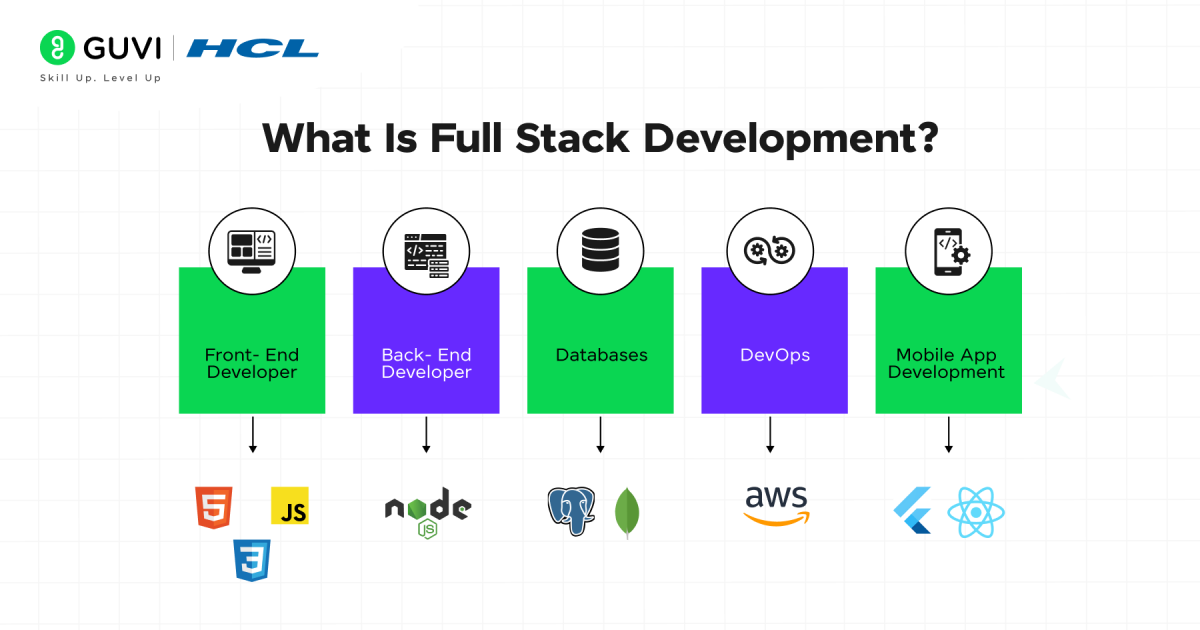
Before heading straight into the roles and responsibilities of full stack developers, you should have a sound understanding about what full stack development is and why it is in-demand all the time. Let’s get started.
Full Stack Development is the end-to-end process of designing, developing, deploying, and maintaining web applications. As a full stack developer, you work on both the front-end (client-side) and back-end (server-side) of an application, ensuring a seamless user experience and robust system functionality.
Modern applications require developers to handle multiple layers of technology, from UI/UX design to database management, API development, security, and cloud deployment. Full stack development is a highly sought-after skill set, as companies prefer engineers who can manage multiple aspects of an application rather than hiring separate front-end and back-end specialists.
Key Components of Full Stack Development
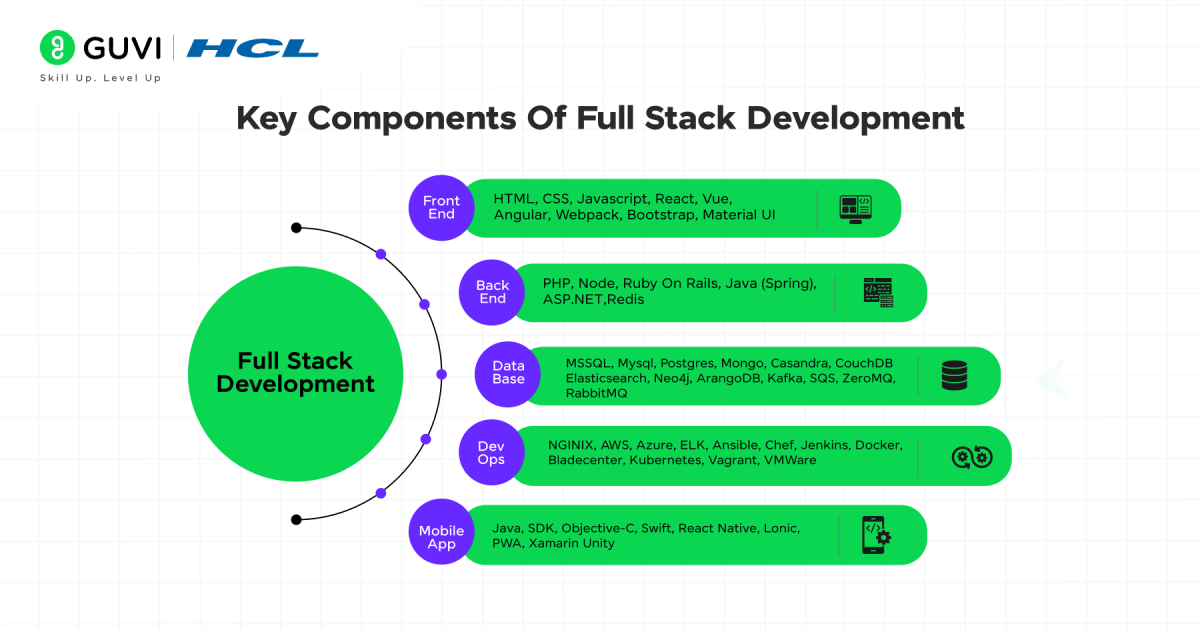
Front-End Development (Client-Side): This involves everything the user interacts with on a website or web application. You will work with technologies like HTML, CSS, JavaScript, and frameworks like React, Angular, or Vue.js to build responsive and engaging interfaces. Optimizing user experience, ensuring cross-browser compatibility, and implementing accessibility standards are crucial aspects of front-end development.
Back-End Development (Server-Side): The back-end is responsible for business logic, database operations, and server communication. You will work with Node.js, Python (Django/Flask), Java (Spring Boot), or PHP (Laravel) to build APIs, manage authentication, and ensure application security. Performance optimization and scalability are key challenges in back-end development.
Database Management: Every full stack developer must understand SQL (MySQL, PostgreSQL) and NoSQL (MongoDB, Firebase) databases to store, retrieve, and manipulate data efficiently. You’ll design schemas, optimize queries, and implement caching mechanisms to enhance performance.
API Development & Integration: Web applications rely on RESTful APIs and GraphQL for communication between the front-end and back-end. As a full stack developer, you will create secure, scalable, and efficient APIs while integrating third-party services like payment gateways, authentication providers, and cloud storage solutions.
DevOps & Deployment: Knowing how to deploy and manage applications in the cloud is a critical skill. You’ll work with AWS, Azure, Google Cloud, and tools like Docker, Kubernetes, and CI/CD pipelines to automate deployment, scale applications, and monitor system performance.
Security Best Practices: Cybersecurity is a major concern in full stack development. You must implement authentication protocols (OAuth, JWT, SSO), secure APIs, prevent SQL injection, cross-site scripting (XSS), and cross-site request forgery (CSRF) attacks, and enforce SSL/TLS encryption.
Top Roles, Responsibilities, and Salaries of Full Stack Developers
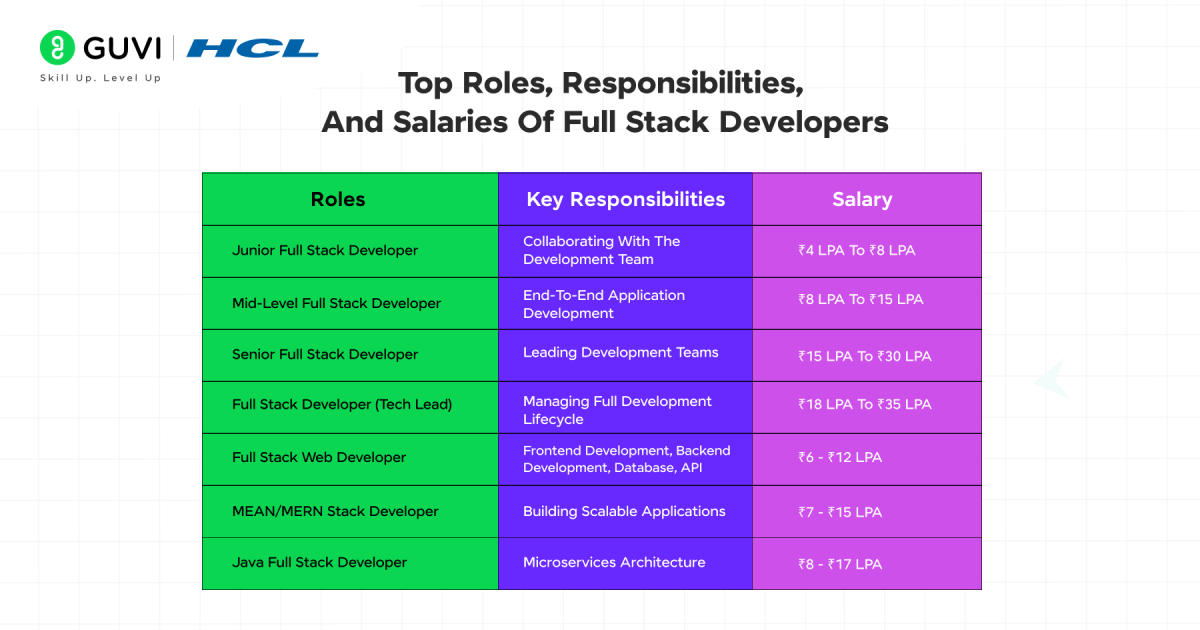
Full Stack Development is a dynamic field that requires developers to work across both the front-end and back-end of an application. The roles in full stack development are diverse, with each requiring a different focus on the skills and technologies used.
Here’s a breakdown of top roles, responsibilities, and salaries for full stack developers in 2025 so that you can pick your career path wisely:
1. Junior Full Stack Developer
As a Junior Full Stack Developer, you’ll be expected to work under supervision, assisting with both frontend and backend tasks. You’ll use technologies like HTML, CSS, JavaScript, and basic server-side programming.
You’ll focus on building and maintaining simple features and bug fixes while learning best practices for application development. This role is ideal for those starting their career and gaining experience in both frontend and backend development
Key Responsibilities:
- Collaborating with the Development Team: Work closely with senior developers to understand requirements and assist in building features.
- Code Maintenance and Debugging: Write clean, maintainable code and debug issues that arise in both the front-end and back-end.
- Assisting in Database Management: Help design and manage basic databases, assisting in queries and interactions between front-end and back-end systems.
Salary in India: ₹4 LPA to ₹8 LPA
As a Junior Full Stack Developer, you can expect an entry-level salary in the range of ₹4 to 8 lakh per annum, depending on the company and your skill level.
2. Mid-Level Full Stack Developer
In this role, you will take on more complex tasks and work with a wider array of technologies. You will be expected to write clean, maintainable code, manage databases, and troubleshoot application issues.
Your work will include designing scalable applications, handling API integrations, and working on both frontend and backend components. You’ll have more responsibility and may begin mentoring junior developers while enhancing your proficiency with frameworks and tools
Key Responsibilities:
- End-to-End Application Development: Take ownership of both front-end and back-end, ensuring the seamless integration of all components.
- Ensuring Application Performance: Optimize the performance of applications and fix bottlenecks in both front-end and back-end systems.
- Database Design and Optimization: Design and manage complex databases, ensuring efficient data storage and retrieval systems.
Salary: ₹8 LPA to ₹15 LPA
As a mid-level developer, your salary could range from ₹8 lakh to ₹15 lakh per annum, depending on your experience and expertise in the tech stack.
3. Senior Full Stack Developer
As a Senior Full Stack Developer, you’ll lead design and implementation of large-scale applications. You’ll manage both the frontend and backend, ensuring code efficiency and scalability.
Your responsibilities include reviewing code, leading teams, and making architecture decisions. You’ll also mentor junior and mid-level developers, ensure best practices are followed, and drive performance optimizations across the stack
Key Responsibilities
- Leading Development Teams: Oversee teams of junior and mid-level developers, providing guidance and ensuring the successful completion of projects.
- Architecting Scalable Solutions: Design the overall architecture of applications, ensuring scalability, security, and performance.
- Integrating Modern Technologies: Incorporate the latest technologies, including microservices, serverless computing, and cloud platforms like AWS and Azure.
Salary: ₹15 LPA to ₹30 LPA
Senior Full Stack Developers in India can earn between ₹15 lakh to ₹30 lakh per annum, reflecting the high skill and leadership required for these roles.
4. Full Stack Developer (Tech Lead)
As a Tech Lead, you will oversee technical aspects of the development process and guide the development team. You will manage the full software development lifecycle, from requirements gathering to deployment.
You’ll coordinate between the development and operations teams, ensure adherence to coding standards, and resolve complex technical issues. Your leadership will be key in delivering high-quality applications on time
Key Responsibilities:
- Managing Full Development Lifecycle: Oversee the development of applications from initial requirements gathering to deployment and maintenance.
- Team Coordination and Mentoring: Coordinate with various departments and mentor junior developers to ensure adherence to best practices.
- Ensuring Code Quality and Security: Maintain high standards for code quality, testing, and security across the stack.
Salary: ₹18 LPA to ₹35 LPA
A Tech Lead earns a higher salary, typically ranging from ₹18 lakh to ₹35 lakh per annum, due to the leadership and advanced technical expertise required for this role.
5. Full Stack Web Developer
In this role, you handle both the frontend (HTML, CSS, JavaScript) and backend (databases, server-side scripting) of web applications. You will be responsible for implementing UI components, integrating APIs, managing databases, and ensuring that applications function seamlessly across devices and browsers. The role demands versatility and deep understanding of web technologies to deliver end-to-end solutions
Key Responsibilities:
- Frontend Development: Building responsive and dynamic UI/UX using frameworks like React, Angular, or Vue.js.
- Backend Development: Developing server-side logic using Node.js, Python (Django/Flask), or Java (Spring Boot).
- Database Management: Working with SQL (MySQL, PostgreSQL) and NoSQL (MongoDB, Firebase) databases for data storage and retrieval.
- API Integration: Creating and integrating RESTful and GraphQL APIs for seamless communication between frontend and backend.
- Version Control: Using Git, GitHub, or GitLab to manage and track code changes.
Salary: ₹6 – ₹12 LPA
6. MEAN/MERN Stack Developer
As a MEAN/MERN Stack Developer, you’ll focus on JavaScript-based technologies like MongoDB, Express, Angular/React, and Node.js. You’ll be responsible for building full-stack applications with a particular emphasis on creating interactive UIs and developing backend APIs. This role requires you to be highly proficient in JavaScript and its frameworks to develop both client-side and server-side solutions
Key Responsibilities:
- Building Scalable Applications: Developing high-performance web apps using JavaScript frameworks.
- State Management: Implementing Redux, Context API, or NgRx for efficient state handling.
- Cloud Deployment: Deploying applications on AWS, Azure, or Google Cloud for scalability.
- Testing & Debugging: Writing unit and integration tests using Jest, Mocha, or Cypress.
- Security & Authentication: Implementing OAuth, JWT, and session-based authentication for user security.
Salary: ₹7 – ₹15 LPA
7. Java Full Stack Developer
As a Java Full Stack Developer, you will primarily work with Java technologies like Spring Boot for backend development and frameworks like Angular or React for the frontend. You’ll design scalable solutions, integrate microservices, and manage databases using SQL and NoSQL technologies. Java Full Stack Developers are valued for their ability to build high-performance enterprise applications with an emphasis on reliability and security
Key Responsibilities:
- Microservices Architecture: Developing scalable microservices using Spring Boot and Hibernate.
- Containerization: Deploying applications using Docker and Kubernetes.
- Database Optimization: Using indexing, caching, and ORM frameworks for performance tuning.
- Security Implementation: Applying best security practices with OAuth2, JWT, and HTTPS.
Salary: ₹8 – ₹17 LPA
Must-Have Full Stack Development Skills for 2025
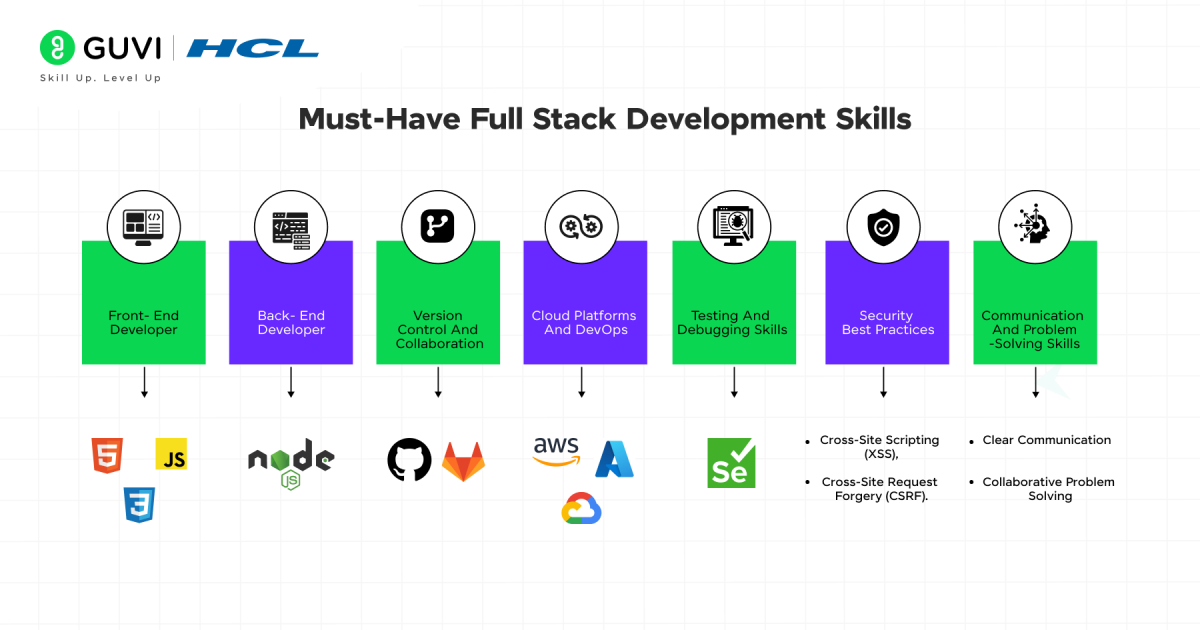
For you to work in the roles we discussed above, you will need to master many full stack development skills and to make it simpler for you, we will discuss everything you must learn in brief now, and it is also covered in detail in a separate article.
As a Full Stack Developer, you are expected to possess a broad range of skills that span across both the front-end and back-end of web development. Here’s a breakdown of the must-have skills for 2025, which are crucial in ensuring that you remain competitive in the rapidly evolving tech industry:
1. Front-End Development Skills
The front-end of a web application deals with everything that users interact with directly. Full stack developers must be adept at creating visually appealing and user-friendly interfaces. Here’s what you need to know:
HTML, CSS, and JavaScript: These are the building blocks of any web application. HTML provides structure, CSS ensures styling, and JavaScript adds interactivity. As a developer, your ability to write clean and efficient code in these languages is foundational to creating a good front-end.
JavaScript Frameworks: Proficiency in modern frameworks like React, Angular, or Vue.js is essential. These tools simplify the development of dynamic web applications. React, for example, enables the development of single-page applications (SPAs) with ease, offering reusable components and a virtual DOM to boost performance.
Responsive Design: With increasing mobile traffic, ensuring that your applications work seamlessly across all devices is critical. You’ll need skills in CSS frameworks like Bootstrap or Tailwind to design responsive layouts. This ensures that your website adjusts fluidly to different screen sizes, from desktops to smartphones.
2. Back-End Development Skills
The back-end is where the logic and database interactions happen. As a full stack developer, you need to be proficient in managing data, server logic, and database connectivity. Here’s what you should focus on:
Server-Side Languages: Mastering Node.js (JavaScript), Python (Django, Flask), Java (Spring Boot), and Ruby (Rails) is a necessity. These languages handle server-side logic and API development. Node.js is particularly favored for its non-blocking, event-driven architecture, which is highly scalable, making it ideal for modern web applications.
Database Management: Understanding both relational (SQL) and non-relational (NoSQL) databases is crucial. You must be comfortable working with MySQL, PostgreSQL, MongoDB, and other databases. This skill involves writing optimized queries and managing data integrity. Knowledge of ORMs like Sequelize (Node.js) or SQLAlchemy (Python) will help you interact with databases efficiently.
API Development: You’ll need to be proficient in developing and consuming RESTful APIs and GraphQL APIs. REST is the most common architecture for API communication, and GraphQL offers flexibility by allowing clients to request specific data from the server. Both are essential for seamless integration between the front-end and back-end.
3. Version Control and Collaboration
As a full stack developer, working with version control systems is non-negotiable. Git is the industry standard for managing changes in codebases. You’ll need to be comfortable with commands for tracking changes, branching, merging, and collaborating effectively with other developers. GitHub and GitLab are widely used platforms that allow developers to store and share code while maintaining a history of changes.
Why It’s Essential: Version control enables efficient collaboration on projects, and allows you to track, manage, and roll back changes to the codebase without losing progress. Mastering Git workflows (feature branching, pull requests, etc.) is key to streamlining development processes in team environments.
4. Cloud Platforms and DevOps
As cloud adoption continues to rise, you must have a deep understanding of cloud platforms like AWS, Google Cloud, or Microsoft Azure. These platforms provide infrastructure for deploying, scaling, and maintaining web applications.
Why It’s Important: Cloud services offer tools for everything from computing resources (EC2, Lambda) to managed databases (RDS, DynamoDB) and storage solutions (S3). Being comfortable with deploying applications on the cloud will allow you to build scalable systems and automate deployment pipelines using CI/CD tools like Jenkins or GitLab CI.
Containerization: Mastering Docker and Kubernetes allows you to package applications and their dependencies in containers, which makes it easier to deploy consistently across different environments.
5. Testing and Debugging Skills
Ensuring that your web applications are robust and error-free requires extensive testing. Full stack developers must be skilled at writing tests and debugging issues that may arise in any part of the stack.
Unit Testing: You should be proficient in writing unit tests for both front-end and back-end components. Frameworks like Jest (for JavaScript), Mocha (for Node.js), or PyTest (for Python) will help ensure that your code functions as expected.
End-to-End Testing: Familiarity with tools like Cypress or Selenium for automating the entire user journey (from the front-end to the back-end) is important. These tests ensure that all parts of the application interact smoothly and that any issue in the stack is caught early.
6. Security Best Practices
Security is paramount in modern web development. Full stack developers must implement security measures to safeguard applications and user data.
Authentication and Authorization: Implementing secure OAuth, JWT (JSON Web Tokens), and OpenID Connect protocols is essential to protect sensitive data. These protocols ensure that users can log in securely and that data is properly validated.
Data Encryption: Ensuring that sensitive data is encrypted both in transit (using SSL/TLS) and at rest is critical. Full stack developers should integrate encryption techniques to prevent unauthorized access to user data.
Security Testing: You must be familiar with security testing tools to identify common vulnerabilities like SQL injection, Cross-Site Scripting (XSS), and Cross-Site Request Forgery (CSRF).
7. Communication and Problem-Solving Skills
As a full stack developer, you will often be the bridge between front-end and back-end teams. Excellent communication skills are crucial for effective collaboration. You should also have strong problem-solving abilities, as full stack development often involves tackling complex issues that require quick thinking and cross-disciplinary knowledge.
Clear Communication: You must be able to explain technical issues in a clear, concise manner to both technical and non-technical stakeholders.
Collaborative Problem Solving: You’ll need to troubleshoot issues across the stack, often requiring you to identify problems in both the front-end and back-end and propose efficient solutions.
If you’re looking to kickstart a career in Full Stack Development and master all these skills we discussed above, GUVI’s Full Stack Development Course is the perfect choice. It offers comprehensive training in both front-end and back-end technologies, equipping you with the skills to build scalable and dynamic web applications. With hands-on projects, expert mentorship, and real-world industry insights, this course ensures you’re ready for the demands of a full stack developer role.
Concluding Thoughts…
Full Stack Developers are critical to the success of modern web applications, capable of managing the entire development process from the user interface to the database and server infrastructure. As the demand for web applications continues to grow, Full Stack Developers with a deep understanding of both front-end and back-end technologies, combined with skills in DevOps and cloud computing, will be in high demand.
Their role requires a continuous commitment to learning and adaptability, ensuring they remain at the cutting edge of technology. Whether working on small startup projects or large enterprise solutions, Full Stack Developers are positioned to lead the future of web development, delivering comprehensive, high-performance applications that meet the needs of users and businesses alike.
FAQs
A full stack developer is responsible for designing, developing, and maintaining both the front-end and back-end of web applications. They work with databases, servers, APIs, and user interfaces to deliver a seamless digital experience.
A full stack developer is expected to have expertise in multiple programming languages, manage both client and server software, and handle end-to-end application development. They should also ensure the application’s responsiveness and efficiency.
Key skills for a full stack developer include proficiency in front-end technologies (HTML, CSS, JavaScript), back-end frameworks (Node.js, Django), database management (SQL, MongoDB), version control (Git), and problem-solving abilities.
A full-stack project manager oversees the entire software development process, coordinating between front-end and back-end teams, managing timelines, and ensuring the successful delivery of projects while balancing technical and managerial responsibilities.
While AI can automate certain tasks, it is unlikely to fully replace full stack developers. Developers’ problem-solving skills, creativity, and ability to understand complex systems are still essential for software development.
























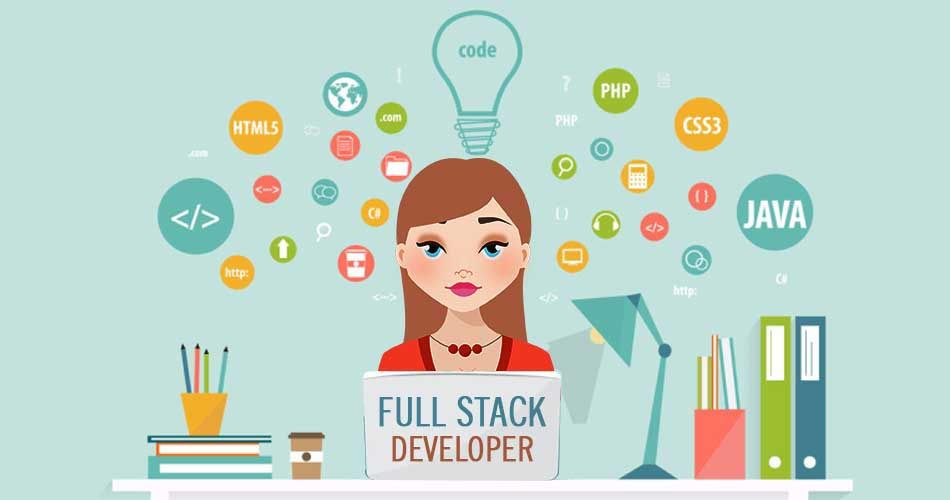


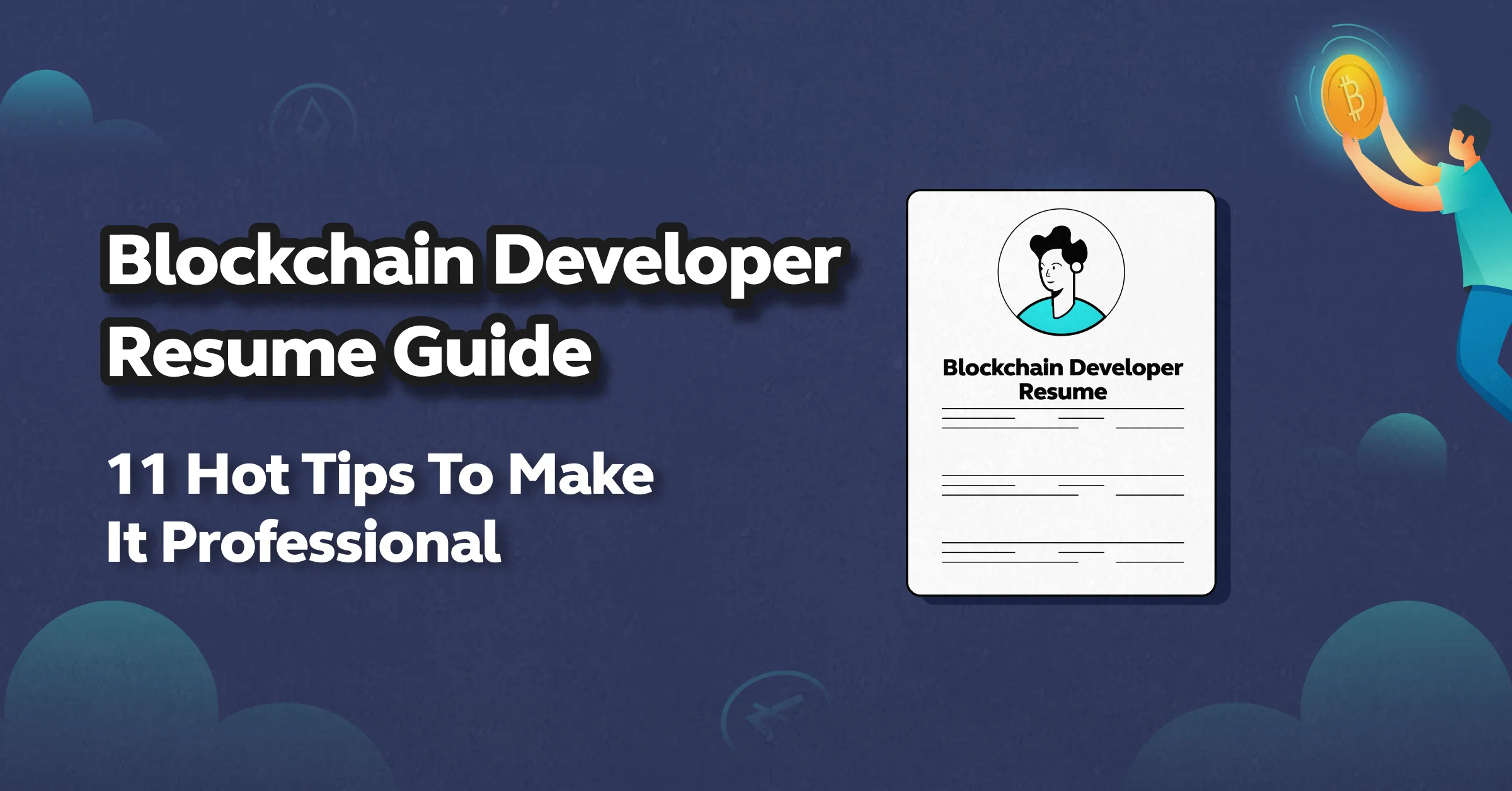
![Top 10 Mistakes to Avoid in Your Data Science Career [2025] 13 data science](https://www.guvi.in/blog/wp-content/uploads/2023/05/Beginner-mistakes-in-data-science-career.webp)


Did you enjoy this article?